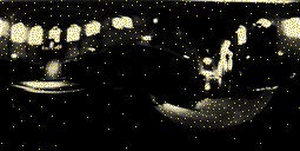Information
- Publication Type: Master Thesis
- Workgroup(s)/Project(s):
- Date: October 2014
- TU Wien Library:
- Diploma Examination: 7. October 2014
- First Supervisor: Michael Wimmer
- Keywords: global illumination, Poisson disk sampling
Abstract
Stochastic sampling is an indispensable tool in computer graphics which allows approximating complex functions and integrals in finite time. Applications which rely on stochastic sampling include ray tracing, remeshing, stippling and texture synthesis. In order to cover the sample domain evenly and without regular patterns, the sample distribution has to guarantee spatial uniformity without regularity and is said to have blue-noise properties. Additionally, the samples need to be distributed according to an importance function such that the sample distribution satisfies a given sampling probability density function globally while being well distributed locally. The generation of optimal blue-noise sample distributions is expensive, which is why a lot of effort has been devoted to finding fast approximate blue-noise sampling algorithms. Most of these algorithms, however, are either not applicable in real time or have weak blue-noise properties.Forced Random Sampling is a novel algorithm for real-time importance sampling. Samples are generated by thresholding a precomputed dither matrix with the importance function. By the design of the matrix, the sample points show desirable local distribution properties and are adapted to the given importance. In this thesis, an efficient and parallelizable implementation of this algorithm is proposed and analyzed regarding its sample distribution quality and runtime performance. The results are compared to both the qualitative optimum of blue-noise sampling and the state of the art of real-time importance sampling, which is Hierarchical SampleWarping. With this comparison, it is investigated whether Forced Random Sampling is competitive with current sampling algorithms.
The analysis of sample distributions includes several discrepancy measures and the sample density to evaluate their spatial properties as well as Fourier and differential domain analyses to evaluate their spectral properties. With these established methods, it is shown that Forced Random Sampling generates samples with approximate blue-noise properties in real time. Compared to the state of the art, the proposed algorithm is able to generate samples of higher quality with less computational effort and is therefore a valid alternative to current importance sampling algorithms.
Additional Files and Images
Weblinks
No further information available.BibTeX
@mastersthesis{CORNEL-2014-AFRS,
title = "Analysis of Forced Random Sampling",
author = "Daniel Cornel",
year = "2014",
abstract = "Stochastic sampling is an indispensable tool in computer
graphics which allows approximating complex functions and
integrals in finite time. Applications which rely on
stochastic sampling include ray tracing, remeshing,
stippling and texture synthesis. In order to cover the
sample domain evenly and without regular patterns, the
sample distribution has to guarantee spatial uniformity
without regularity and is said to have blue-noise
properties. Additionally, the samples need to be distributed
according to an importance function such that the sample
distribution satisfies a given sampling probability density
function globally while being well distributed locally. The
generation of optimal blue-noise sample distributions is
expensive, which is why a lot of effort has been devoted to
finding fast approximate blue-noise sampling algorithms.
Most of these algorithms, however, are either not applicable
in real time or have weak blue-noise properties. Forced
Random Sampling is a novel algorithm for real-time
importance sampling. Samples are generated by thresholding a
precomputed dither matrix with the importance function. By
the design of the matrix, the sample points show desirable
local distribution properties and are adapted to the given
importance. In this thesis, an efficient and parallelizable
implementation of this algorithm is proposed and analyzed
regarding its sample distribution quality and runtime
performance. The results are compared to both the
qualitative optimum of blue-noise sampling and the state of
the art of real-time importance sampling, which is
Hierarchical SampleWarping. With this comparison, it is
investigated whether Forced Random Sampling is competitive
with current sampling algorithms. The analysis of sample
distributions includes several discrepancy measures and the
sample density to evaluate their spatial properties as well
as Fourier and differential domain analyses to evaluate
their spectral properties. With these established methods,
it is shown that Forced Random Sampling generates samples
with approximate blue-noise properties in real time.
Compared to the state of the art, the proposed algorithm is
able to generate samples of higher quality with less
computational effort and is therefore a valid alternative to
current importance sampling algorithms. ",
month = oct,
address = "Favoritenstrasse 9-11/E193-02, A-1040 Vienna, Austria",
school = "Institute of Computer Graphics and Algorithms, Vienna
University of Technology ",
keywords = "global illumination, Poisson disk sampling",
URL = "https://www.cg.tuwien.ac.at/research/publications/2014/CORNEL-2014-AFRS/",
}

 thesis
thesis

